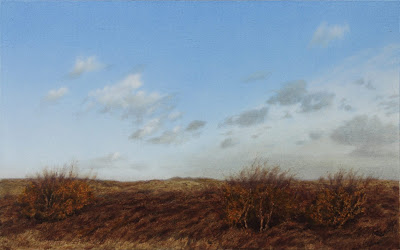I needed a fast, uncomplicated small composition for one of my Open Eye Small Scales (21x15cm), and this really fitted the bill. It's a composite of a couple of snaps taken a minute or so apart along the A85 westwards from Perth – the sky and right trees from east of West Huntingtower, and the left trees and landscape from west of West Huntingtower (a small village near Huntingtower Castle).
I don't actually remember the composing bit, but I think I threw the two sources together fairly rapidly and quite possibly late at night. I seem to have mistakenly deleted the series of composition files made putting it together – which is annoying.
This is the first painting I've done in a while using a grey primer. It seemed a very good idea as the piece had to be done very fast, and was going to be quite dark overall anyway. I had seen that Michael Harding had introduced a new grey acrylic primer so, this was an opportunity to try it out. After the initial setting out and quite a cursory fluid acrylic development stage, a lot of the oil paint was opaque right from the start. The initial landscape mixes were Oxide of Chrome Green, Mars Black, and Unbleached Titanium Dioxide – all very opaque pigments. Likewise the sky was built with Titanium White onto the grey priming, with tints of blue and modifying thinner patches of whites and dark greys. The low blue band was a few finely-stippled and increasingly dense layers of semi-transparent, Damar varnish heavy, Ultramarine and Zinc White mix.
The grey primer was a pleasant change. It's very densely pigmented, covers easily, and is sold as being very non-absorbent – so that oil colours won't go flat when drying (I didn't notice any difference to be honest). What's very interesting is that instead of using chalk for its filler it uses marble dust, so it has a very fine but quite definite 'tooth' to it. Not that that was a particular plus for me – I like a smooth, nearly polished surface – but it's interesting to notice it.
If you think you've heard the name 'Huntingtower' before, it may be because it's the title of a novel by John Buchan. I can't say I've ever read the book, but I did hear a very enthusiastic BBC radio drama adaption years ago, which might even have been in stereo.
There's really not that much more to say about this one except that it was quite efficiently done, and that I took a great deal of pleasure in exaggerating the Low Blue band above the skyline.
That's two Small Scales now in the Open Eye. The online-only show has been up on the website for a while now - nearly three hundred at a time – and I expect mine will join the rotation shortly. Once my third one is finally finished and delivered, I'm going to take a break for a few weeks, or more, to recharge my drained-out ArtyBatteries.
Meanwhile have a good Festive Holiday and New Year. I hope we all have better times and fewer worries in 2022, and that the Greek Alphabet remains as obscure as it always has been for most non-classicists.












